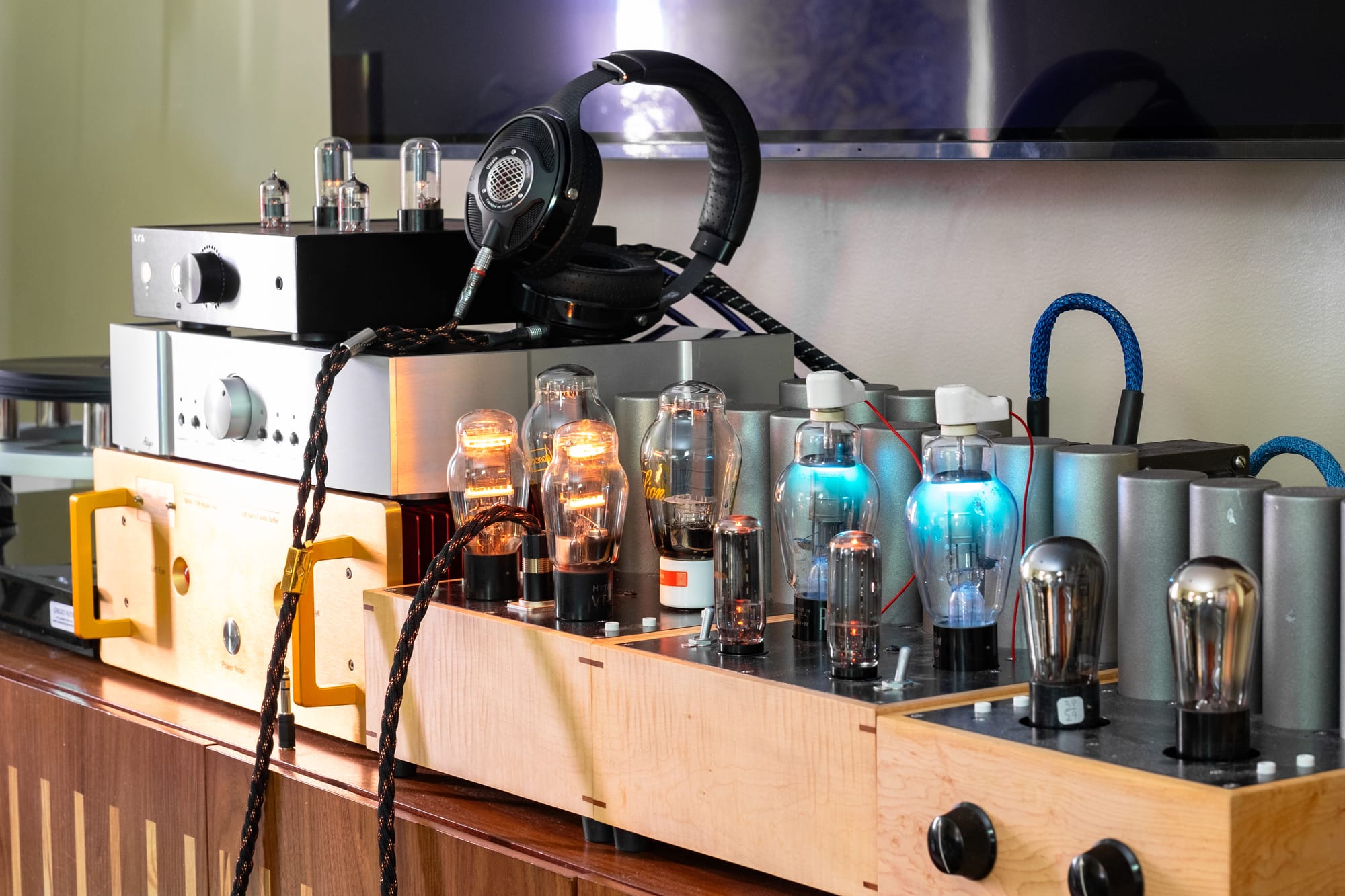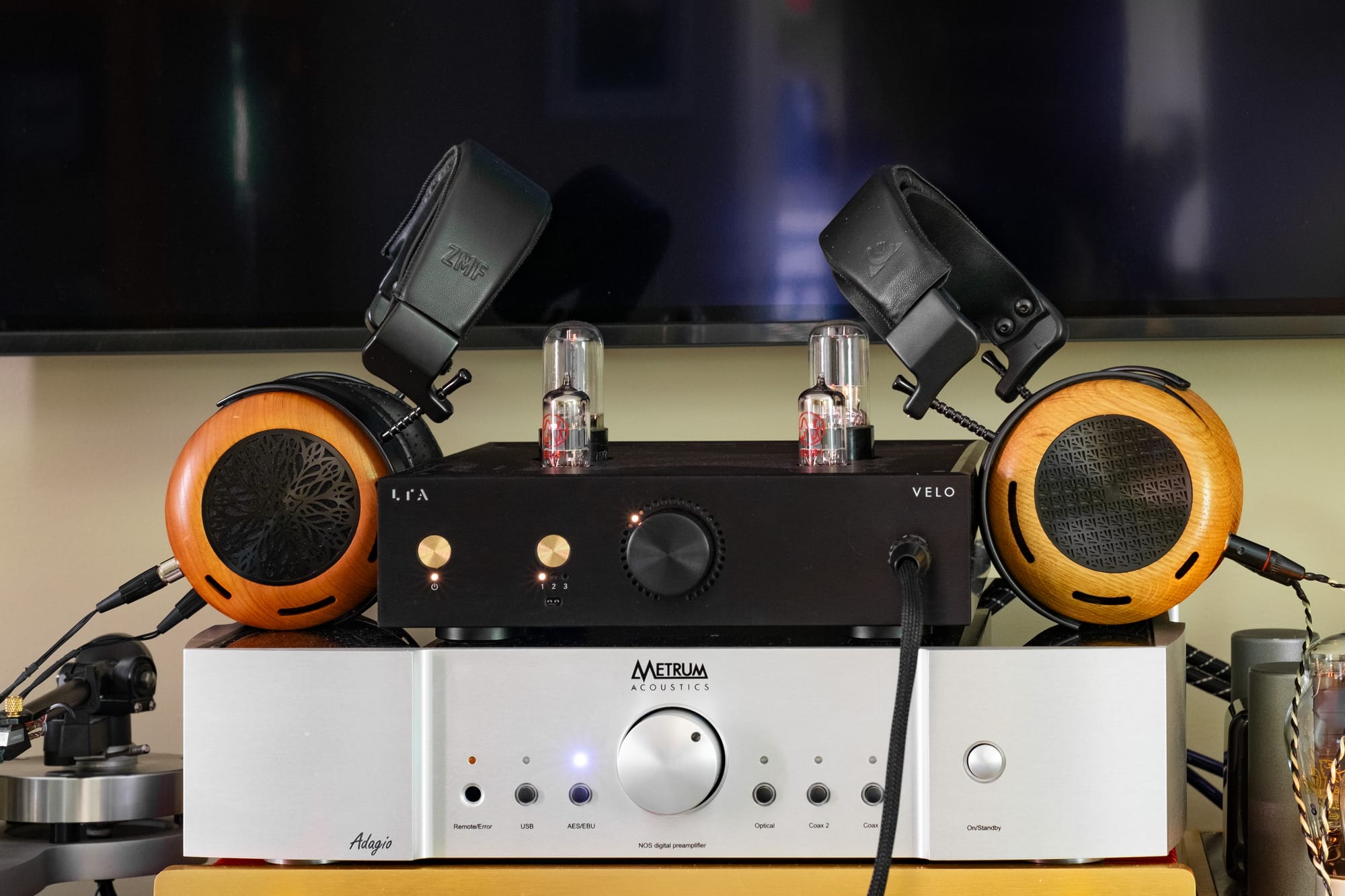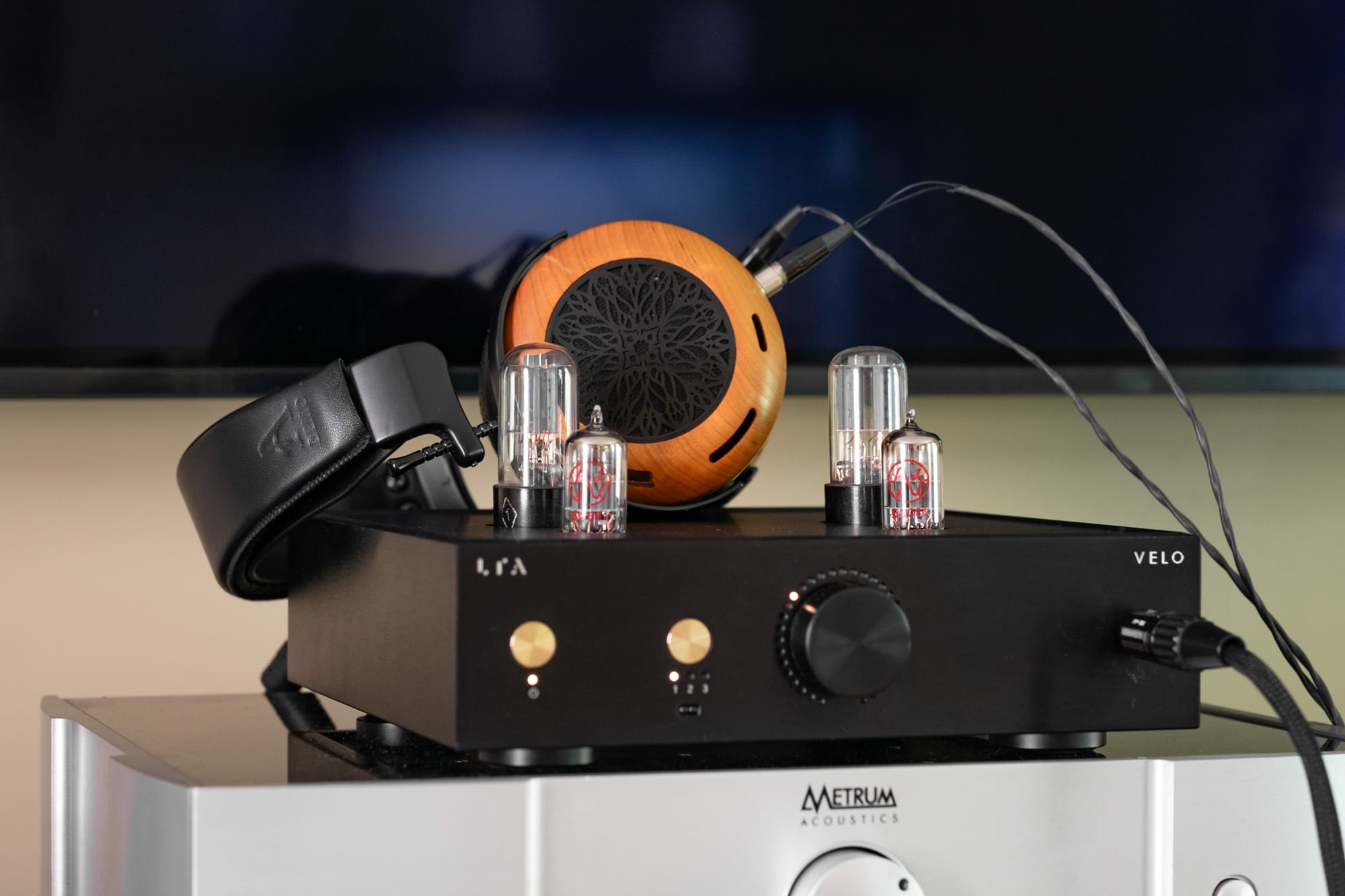It's no secret I'm very fond of tube amplifiers. Most of my critical listening and comparisons involve them. I do use solid state amplifiers for convenience, as I don't like the idea of "wasting" tube life by turning an amplifier on then off after a half hour if I need to leave or can't find anything I want to listen to. I also tend to prefer tube amplifiers that don't lean warm-sounding. My Neurochrome DG300B doesn't get much use because, even though it was created by a designer that intended for the DG300B to be an objectively well-performing amplifier, it is still a little too warm for my preferences. Instead, I tend to use my less warm push-pull Esoteric A100 or even less warm Oliver Sayes 300B/801A amplifier. My search for a good tube headphone amplifier that can actually fit on a desk has lasted almost a decade, and when LTA offered to send their Velo for review, I couldn't have been more excited.
OTL vs. OTC
I hesitate to speak in broad strokes because I can think of many exceptions to the following, but for the sake of those reading this review and are unfamiliar with the difference between tube amplifiers, output transformer-less (OTL) amplifiers are often known to be somewhat warmer and can have higher even order ("pleasant sounding") distortion than output transformer-coupled (OTC) amplifiers, which still have more even order distortion than solid state amplifiers, but because of the addition of the transformer in the circuit, often have more odd order ("harsh sounding") distortion than OTL designs. So why design an OTC amplifier in the first place? A big issue many OTL designs have is that it's not uncommon for OTL amplifiers to have high output impedance, which can affect dynamic headphones' frequency response drastically. Many OTC amplifiers, in contrast, have lower output impedance. In the headphone world, OTC amplifiers often output more power than OTL amplifiers as well, which makes them a more natural pick for headphones people believe need the extra power, like planar magnetic headphones.
What is ZOTL?
Linear Tube Audio's implementation of ZOTL (Zero-Hysteresis Output Transformer-less) architecture is unique from other OTLs in many ways. Rather than clumsily explaining ideas that, frankly, are over my head, David Berning's website contains the patents and white papers: https://davidberning.com/technology. In practical use, the Velo's output impedance of 1.1 ohms allows for a wide array of headphones to be used without affecting frequency response with the Velo. In contrast, the Bottlehead Crack, which can have an output impedance of over 150 ohms depending on tube type, can significantly affect the frequency response of dynamic headphones.
Review Chains
As the Velo functions as both a headphone amplifier and a preamplifier, I used both functions in the following chain:
HQPlayer (sinc-mg filter) -> Afterdark Rosanna Diretta Network Bridge -> USB Fiber Isolator -> Accurate Audio DIP-B660 DDC -> Metrum Adagio -> Velo -> Oliver Sayes 300B/801A or Esoteric A100 when Velo is used as a preamp
Headphones used: Audio Technica AD2000, Aurorus Audio Borealis, Focal Utopia, Nightjar Singularity, Nitsch JAR600, Sennheiser HD580, Sennheiser HD650, ZMF Atrium, ZMF Caldera
Speakers used: Lii Audio Origin S10

Sound
One of my favorite amplifiers I have owned was an Eddie Current Zana Deux SE OTL. It was a very colored amplifier that didn't work with everything due to its warmth, but it had a wonderful, almost blown-out, soundstage with a strong amount of wetness, or added decay. Unlike the Bottlehead Crack, though, it rarely went too far in warmth to the point of sounding mushy. For a long time, I believed I was too sensitive to low midrange and upper bass issues to really gel with an OTL, but the Zana Deux showed me that there is a way to get that sound without going too far. Since then, I've heard many other OTLs that I wish I could incorporate into my system, but I only have a limited amount of space. That is where the reasonably sized Velo comes in to get me excited about the possibility of owning an OTL all over again.
This first section will describe the Velo's sound as a headphone amplifier. The second, shorter section, will compare the Velo with my normal preamp, an Oliver Sayes Type 26 TVC with Tango IPTs.
Bass
Bass is an area in which I have noticed lower end OTLs can struggle. I have no actual backing for this, but most cathode follower OTLs I've heard do seem to especially struggle with sounding clean, possibly due to the implementation of a cathode follower that, while introducing 100% negative feedback, doesn't prioritize reducing the resulting distortion. This issue isn't as pronounced in the higher-end OTL headphone amplifiers I've heard, like the Allnic HPA-5000 and Apex Teton, but more economical OTLs I've heard like the Darkvoice 336 and Bottlehead Crack do seem to need a bit of work. The Bottlehead Crack does attempt to fix this distortion with its Speedball Constant Current Sink (CCS) to improve linearity. The Speedball mod does clean up the Crack a bit to me, but it loses enough of the amp's original character that, despite thinking the stock Crack is too warm, I prefer it to the CCS-modded version.
The Velo, due to its ZOTL architecture, has zero global feedback, which, in addition to circumventing the distortion-reducing measures normal OTL amplifiers deal with, may be what contributes to what is very clean bass for a tube amplifier. At times, I forgot I was actually using a tube amplifier and instead was using a solid state amplifier with shockingly good tone. It's not perfect, however, as nothing is. While the bass isn't sloppy--far from it--it doesn't have the strong sense of sheer force a good solid state amplifier can have. This isn't necessarily a negative, as this performance aligns with tube amplifiers I've heard in this price range and even quite a bit above, like the Feliks Audio Envy.
Midrange
Midrange is where I feel most tube amplifiers shine. I've been searching for a solid state amplifier that reproduces the tone of even an "okay" tube amplifier for a long, long time. Solid state amplifiers often just have a tinge of harshness, possibly in odd-order distortion, that puts me out of the music just enough to bother turning on my tube amplifiers instead of basking in the convenience of solid state. The Velo is no exception, with some slight caveats. Compared back to back with the Apex Teton, at varying volumes, the Velo actually sounded a little denser in low midrange but didn't quite match the liquid midrange magic of the Teton. Now, the Teton was released at over double the price of the Velo and is next to impossible to find, but the difference in sound forced me to reflect on how unique the Velo sounds in relation to the OTL market. It makes some concessions in that it doesn't quite have the magic of a high end OTL but, in turn, has not made any headphone I've plugged into it sound worse. The Aurorus Audio Borealis, which I typically use strictly with solid state amplifiers as it's fairly low impedance and usually falls apart out of my tube amplifiers, blossomed with the Velo. It tamed its sometimes papery-sounding midrange and gave it more life in balancing out its slightly dry sound. It even worked fantastically with my Nightjar Singularity, with no perceptible noise for the IEM.
Treble
One of the most hit-or-miss aspects in an OTL amplifier for me is treble reproduction. Some OTLs have measurably rolled off top end, which in turn actually does create a presentation that's a little too dull for me. This does not seem to be the case with the Velo, which never gave me any inkling of lacking air. I also did not notice any grain in the treble, nor did it ever sound too smoothed over, as the Velo does reproduce texture well enough to satisfy my needs.
Imaging
As mentioned earlier, the Velo does not have the blown-out sound stage other OTLs can give, but I do think it has a leg up over my solid state amplifiers, which is enough to give it a positive mark. It does make up for its relatively smaller soundstage by reproducing a fairly believable image that can be lost when an OTL exaggerates soundstage.

Preamplifier Performance
I don't have anything that is exactly a fair comparison to the Velo as a preamplifier, but I do think it is a compliment that I feel comfortable comparing it to my reference preamp, my Oliver Sayes Type 26 DHT preamplifier with a Blore Edwards Slagleformers and Tango input transformers. It's what I consider to be my personal ceiling and has a very smooth midrange that, not unlike some OTLs, can actually add a bit too much character. If I had any complaints about it, I think it occasionally imparts a little too much of, for lack of a better descriptor, creaminess to the sound. It's lovely and enveloping, but I find myself bypassing the tube stage at times, when I want a more aggressive presentation.
The amplifiers I am using for comparison are my Esoteric A100 and much more esoteric (sorry) Oliver Sayes 300B amplifier, which uses 801A drivers, 866A mercury rectifiers, Lundahl interstage transformers, and Electaprint silver output transformers. This amp is pretty much as close to the opposite of the Velo in terms of usability. Turning it on is a two-stage process: one "on" switch is actuated to activate the heaters, which vaporize the mercury in the 866A for about ten minutes, after which I can finally flip the other switch. I then need to dig out the multimeter to ensure the 801A and 300Bs are correctly biased. It's ridiculous, but for the sound I'm rewarded with for dealing with this, I think it's absolutely worth it. I have yet to hear any of the multi-kilobuck amps like Viva's 845 or Feliks Audio's Envy do, frankly, anything better than it. All this buildup is to say...
...damn it, the Velo doesn't embarrass itself against my beloved preamp. As it does as a headphone amplifier, it strikes a nice middle ground between the overly "emotional" tube stage and the "straight" sounding TVC mode. The Velo doesn't have the lovely tone of a 26 tube, but I don't need that when I'm listening to, for example, Tool. But I do sometimes wish I had the extra body when listening to driven music, which is where the Velo comes in and performs with aplomb. And it's in a package that was so light that I overlifted it the first time I picked it up. I haven't even been able to explore the viability of improving the Velo further by tube rolling with nice 6SN7s, as that's a route I have avoided on purpose (I can get like, 10 nice Type 26 tubes for the price of one nice 6SN7!).
I don't think the Velo can outright replace my Sayes preamp, as I do think my Sayes preamp is a little more resolving of decay and a little more realistic in its transients, but, like the Teton, the difference in price has to be taken into account, and for half the amount of money, I'm impressed with how well the Velo keeps up. I am more impressed with the Velo’s performance as a headphone amplifier, but I never felt that as the Velo was not adept at functioning as a preamplifier. As the Velo’s headphone amplifier and preamplifier circuits are one and the same, I simply feel that the Velo puts itself ahead of the, frankly, less than impressive headphone amplifier competition more decisively. If I have any complaints about the Velo's performance, it's that while midrange performance was good, its bass sounded a little too rounded and lacking texture compared to what I'm used to hearing from my own setups.
Conclusion
I really, really like the Velo. I like it so much I seriously have been considering buying the demo unit, despite already having five other tube amplifiers gathering dust. The Velo is not the best tube amplifier I've heard, but it's the most versatile. Even my Millett Sangaku imparts a bit too much warmth for me, and that doesn't even use traditional tubes! The Velo really makes a case for being happy with, "good enough." Though "good enough" is easy to be happy with when it sounds like this.

Comments?
Leave us your opinion.